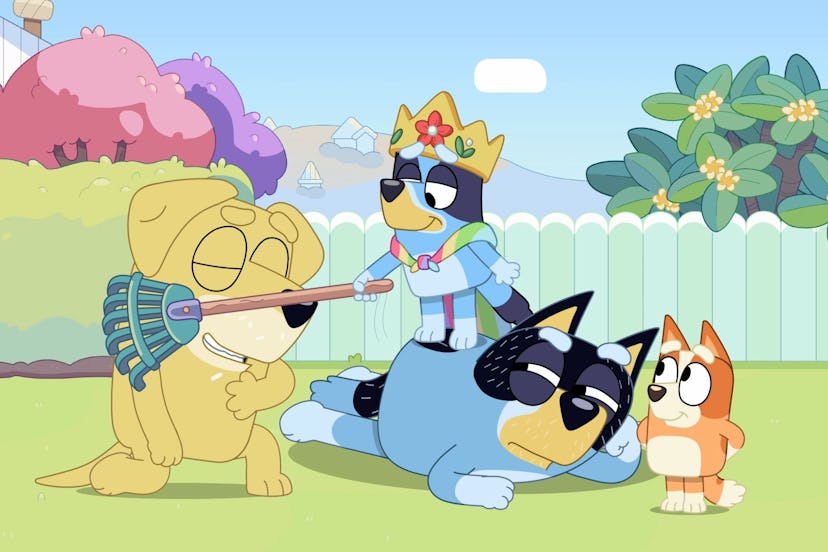All Around The World, Bluey Characters Have Alternate Names— And Sometimes Different Genders
Bluey may be just “Blue” in some countries, but the heart of the show is the same.

Five years ago, Bluey debuted in its home country of Australia in 2018, and less than a year later started to arrive in other countries courtesy of Disney. When Bluey first touched TV screens five years ago, it was only available in English. Today, the popular animated series about to conclude its third season is available in over 60 countries with dubs in more than 20 languages, including Spanish, French, Chinese, German, Korean, Arabic, Turkish, and others.
The unspoken language of Bluey is about love and friendship, but to communicate that message, the show must be translated from one lexicon to another. As any anime fan already knows, dubbing doesn’t mean a direct word-for-word rendition of a line of dialogue. It requires some modifications, and when it comes to Bluey, those adjustments can mean more than just dialogue. Here’s how Bluey is different around the world, for real life!
Lost in Translation
Just as Bluey has faced some censorship issues on Disney+ in North America, the show has also had its fair share of changes in other countries. The controversial “Dad Baby” has still not aired in many places outside of its Australian homeland. But changes to the show are more frequently related to localization, rather than controversy.
Generally, changes are made to reflect the culture of the place where Bluey is airing. That can mean changes in terminology or phrasing, like how “capsicum” in the UK version is changed to “pepper” in the US.
The Heeler family isn’t quite the same if you live in other parts of the world
The most common thing to be altered in the series outside of content is the gender of the characters. Despite so many people mistaking Bluey for a boy, she’s always a girl no matter what country she appears in. Things start to get confusing with her extended family, particularly Stripe and Trixie’s kids. In Arabic and Dutch, Muffin is a boy instead of a girl. Likewise, her sister Socks is a male in Dutch, Hebrew, and a few other languages.
Other characters have had their genders swapped in different countries, including Jack’s sister Lulu becoming his brother in the Dutch dub. Lucky is now a female in the Icelandic iteration, while Bentley has become a boy in the Italian version. Why these changes were made could have a variety of explanations: Different non-English words having different female and male nouns, or simply mistakes in the dubbing.
Rarely in the dubs are the names of characters changed, but it’s not a stretch for it to happen either. Users on Reddit have shared stories about some of these changes, including how Chilli is named Caramela in the Romanian version, along with Bluey simply being called “Blue.” Bandit has a few more alter egos besides Romeo Mcflouish, reportedly renamed “Billy” in Sweden and “Buster” in Dutch.
There are plenty of other changes in the immediate family and friends of Bluey, altered to better suit the needs of each country, whether that reason be linguistics or finding something similar to their cultures for a name that otherwise has zero relevance; such as Snickers being renamed “Wafel” in Polish.
More Than Words
Bluey and Jean-Luc build together in “Camping,” but this episode has a key difference in one part of the world than others
One of the most fun Bluey episodes to watch in a different language is a story all about communication. In “Camping,” Canadian Jean-Luc becomes fast friends with Bluey, but has difficulties understanding each other first since JL only speaks French. In the French dub, Jean-Luc is Johnny and speaks English, although his Canadian origins remain the same. (Of note, Jean-Luc Picard, as played by Patrick Stewart in Star Trek: The Next Generation was called “Johnny” by his friends at Starfleet Academy when he was a young man. Coincidence ?)
Another episode that uses this language as part of the plot is “Pavlova,” where Bandit masquerades as a French chef trying to help Bingo expand her taste buds. In the French-speaking version, Bandit instead adapts an Italian accent.
The third-season episode “Turtleboy” is unique in that it focuses on Dougie, a young hearing-impaired dog who uses sign language to communicate non-verbally. However, sign language is not universal, as every nation has its own set of gestures and movements to express themselves. Auslan is what’s used among Australia’s Deaf community, and relies on using all five fingers. The staff at Bluey worked diligently to use only phrases that could be signed with four fingers like the characters in the show have, and an episode with an Auslan interpreter was made available through Australia’s iView platform.
No matter what language Bluey is enjoyed with, families can always expect the same gratifying level of high-quality entertainment that kids and parents can connect with on multiple levels. For those who have already binged every episode multiple times, why not try watching with a different language on Disney+, and discover what the Heeler family is saying from a different perspective?